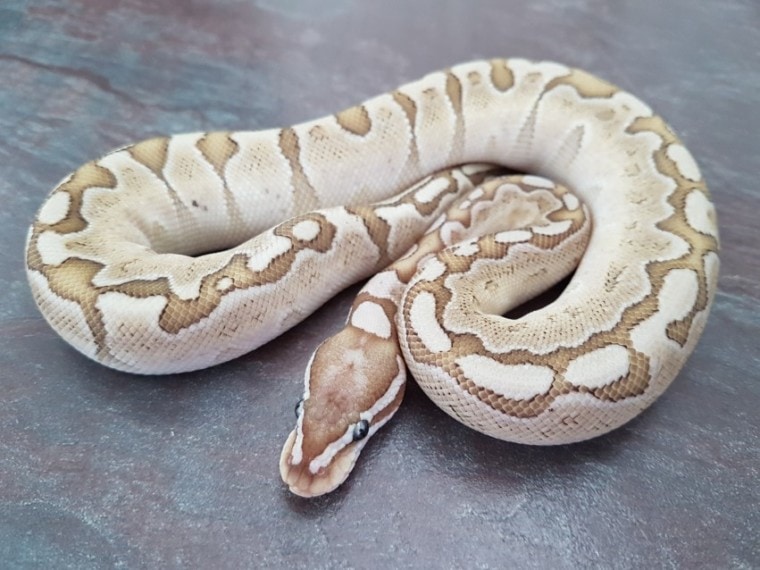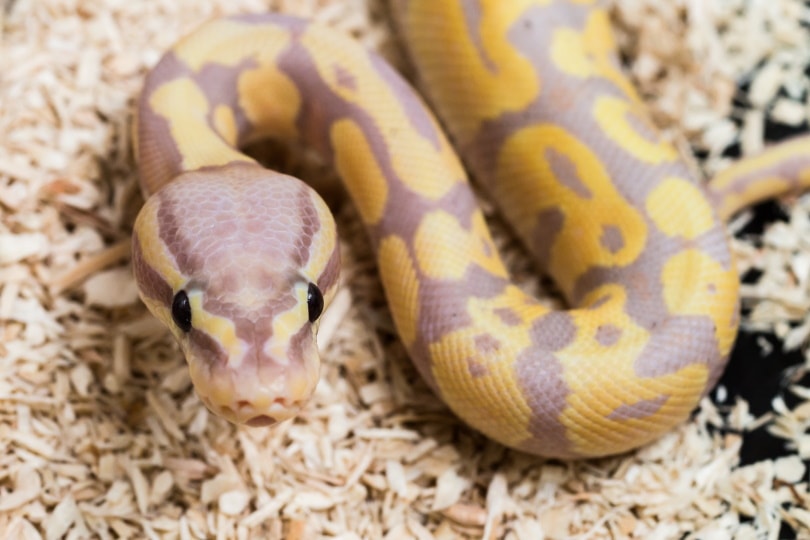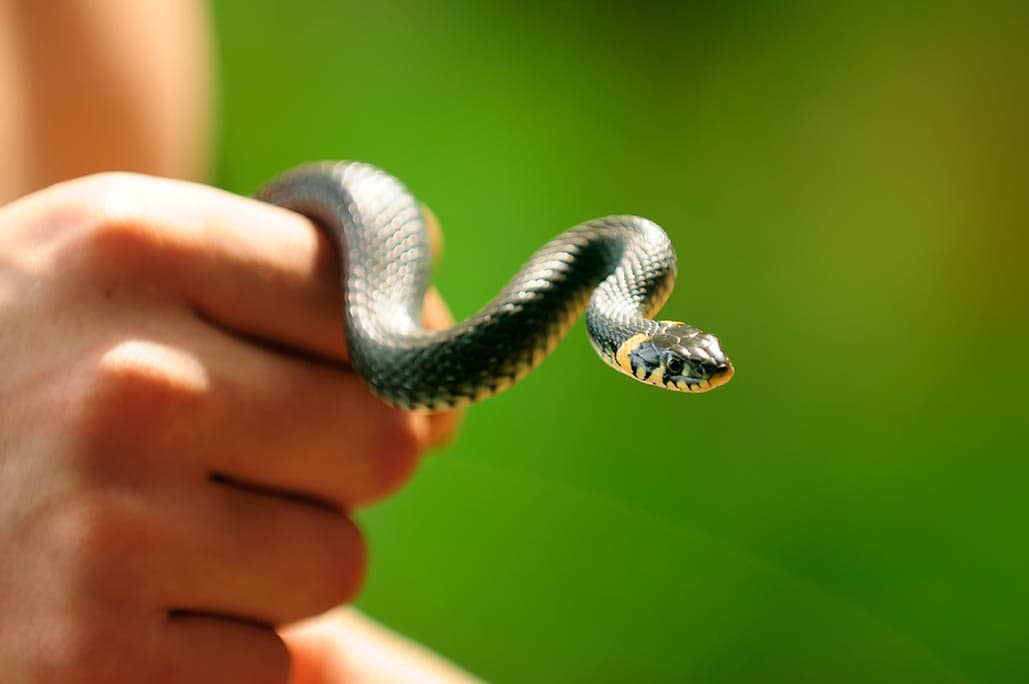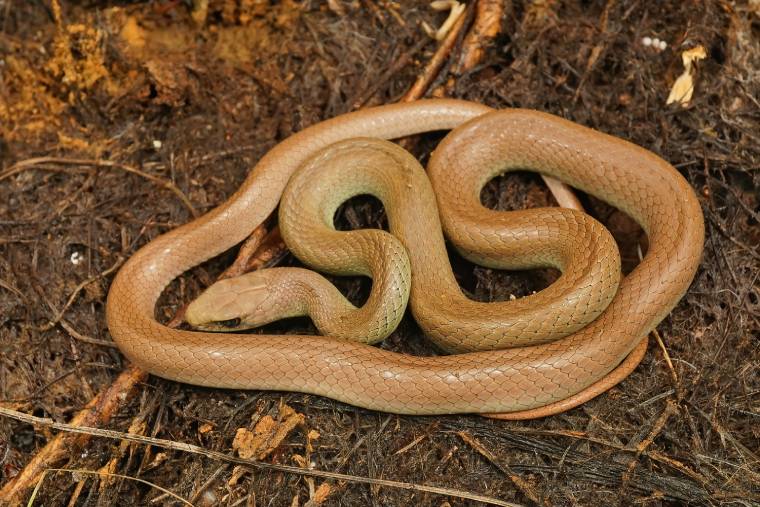
The bamboo ball python is a relatively new morph, which can make them more difficult to find than other ball pythons. Keep reading our guide to learn more about these snakes and whether they are a good fit for you and your family!

Quick Facts about the Bamboo Ball Python Morph
| Species Name: | Python regius |
| Common Name: | Royal python, ball python |
| Care Level: | Low |
| Lifespan: | 20-30 years |
| Adult Size: | 3-5 feet |
| Diet: | Primarily rodents |
| Minimum Tank Size: | 30-60 gallons |
| Temperature & Humidity: | 78° F to 95° F (basking spot), 40%-60% humidity |
Do Bamboo Ball Pythons Make Good Pets?
Like other ball pythons, the bamboo ball python can make a great pet, even for a beginner. While 3-5 feet may seem big, ball pythons are actually fairly small compared to other constricting snakes. Their small size in combination with their docile nature makes them easy to handle. Additionally, their tanks don’t need to be as big as other, larger species, which means they’re appropriate for many different types of homes because they take up less space.
Appearance
Bamboo ball pythons are characterized by a pale belly contrasted by a dark green “bamboo” pattern on their backs. You can also find pastel bamboo ball pythons, which tend to be more vibrantly colored. As they get older, bamboo ball pythons will start to lose their coloring and may begin to develop brown spots.

How to Take Care of a Bamboo Ball Python
Habitat, Tank Conditions & Setup
Tank
Your bamboo ball python’s tank should be at least 30 to 40 gallons large. Of course, you can always buy a larger tank if you have the space; there is really no such thing as too big. Provide your snake with a shelter or some other place to hide in the tank. In terms of cleaning, you can spot clean the tank as needed. Plan to clean the tank in its entirety about once a month.
Lighting
While you do not need to provide UVB lighting for your bamboo ball python, you can still choose to include it in your snake’s tank. You should also add at least two heating lamps: one for the day and one for the night. These lights should be on a 12-hour cycle to simulate daylight.
Heating (Temperature & Humidity)
In addition to providing your snake with a place to bask, you should also make sure there is a “cool” area in the tank where it can go if it gets too hot. The basking area temperature should be about 95° F and the cool area should be around 78° F. In addition to heat, the tank needs to be moderately humid, between 40% and 60%.
Substrate
Ball pythons are not especially picky when it comes to substrate; as long as the substrate is relatively porous and can maintain a level of humidity in the tank, it will probably work. Some ball python owners prefer sphagnum moss, but aspen shavings will also do.
Tank Recommendations
| Tank Type | Minimum 30-gallon glass vivarium |
| Lighting | 2 bulbs on 12-hour timers |
| Heating | Heating pad under the tank, incandescent light bulbs |
| Best Substrate | Sphagnum moss or aspen bedding |

Feeding Your Bamboo Ball Python
You should cater the type and size of prey you feed your snake to his size. The prey should be about the size of the widest part of your snake, but no bigger. Hatchling and juvenile bamboo ball pythons can eat crickets and pinky mice, while adults can handle adult rats and mice.
You do not need to feed your snake every day. Aim to feed a young snake about every 5 to 6 days. Adults need to eat even less frequently, once every 10 days to once every 2 weeks.
Diet Summary
| Fruits | 0% of diet |
| Insects | 0% of diet (but some juveniles eat crickets) |
| Meat | 100% of diet – small/medium-sized rodents |
| Supplements Required | N/A |
Keeping Your Bamboo Ball Python Healthy
Even though you probably won’t be handling or interacting with your python as often as you would another kind of pet, it is important to keep an eye on your snake to make sure it is healthy. Like all other animals, bamboo ball pythons are prone to certain health conditions that you need to be aware of. A healthy snake should have clear eyes and should shed and eat regularly. A snake that is experiencing a health issue might shed more often than usual, develop bumps on its skin, or seem reluctant to eat. Note that there are some perfectly normal reasons why a snake might not want to eat; for example, when a snake is about to molt, it may lose its appetite.
Below are some common health problems that your bamboo ball python could develop.
Lifespan
The average lifespan for a bamboo ball python is between 20 and 30 years, but they have been known to live longer. While they are low-maintenance pets, you need to understand that these are not the kind of pets you should buy on a whim as they will be with you for a long time.
Breeding
If you are interested in breeding your ball python, there are a few things you should know. First of all, your female snake should be healthy, well-fed, and relatively large before she begins breeding; smaller snakes are more likely to suffer health problems associated with breeding. Males don’t need to be as large as females, but they should be at least 18 months old. When you are ready to begin the process, you should create an environment that mimics the natural world during your snakes’ typical breeding season. Since ball pythons tend to breed in the fall, you can gradually lower the night temperature of the tank to the low to mid-70s F.
Note that when a bamboo ball python is pregnant, she may refuse to eat toward the end of her pregnancy. This is perfectly normal; once she lays her eggs, she will regain her appetite.
Are Bamboo Ball Pythons Friendly? Our Handling Advice
Overall, bamboo ball pythons are known to be docile animals that take well to being handled by humans, but that doesn’t mean that your snake will be interested in being handled right away. Give your snake some time to adjust to its new environment when you first bring it home. You should also take care to avoid handling your snake when it hasn’t eaten in a while to avoid being bitten.
When you do handle your snake, make sure to use both hands in order to support your snake’s entire body and head. Keep a fairly loose grip on your python to allow it to move up and down your body. Snakes need to use their core to climb, so don’t be too worried if it starts to wrap itself around you; it is not trying to harm you, and even if it were, you are much too large for your ball python to successfully constrict.
Even though ball pythons tend to tolerate handling fairly well, don’t try to handle your snake more than about once a day. Snakes are not social creatures, and handling your snake too often can cause it to become stressed.
Shedding: What to Expect
Snakes need to shed their skin regularly. You can expect your bamboo ball python to shed about every 4-6 weeks. You will know that your snake is getting ready to shed its skin when its scales start to look loose. Its eyes may also seem cloudy. Provide your bamboo ball python with a water bowl for soaking and some sort of moist substrate such as moss, to help your snake shed its skin more efficiently. You should never “help” by trying to remove the skin yourself.
How Much Do Bamboo Ball Pythons Cost?
Ball pythons tend to cost around $50, but morphs such as the bamboo ball python usually cost more. You can expect to pay up to $500 for one of these snakes. Make sure to do your homework before buying a snake from a breeder. Don’t be afraid to ask questions about your snake and the breeder’s practices.
Care Guide Summary

Conclusion
Overall, bamboo ball pythons can be great pets, especially if you are new to reptiles. Because they only need to eat once a week or less, they are fairly low-maintenance pets. If you are thinking about buying one of these snakes, however, you should consider their lifespan; with the proper care, these snakes can live 30 years or longer. If you are ready to commit to an animal for many years to come, the bamboo ball python could be a great fit for you!
Featured Image Credit: Deb Davis, Shutterstock








